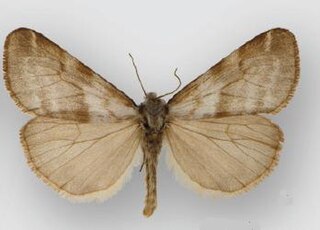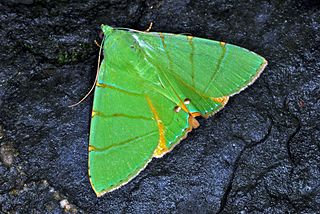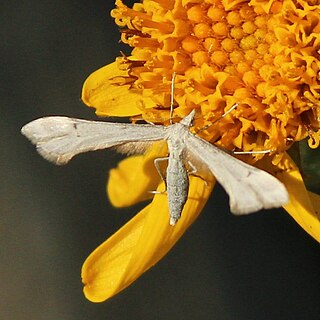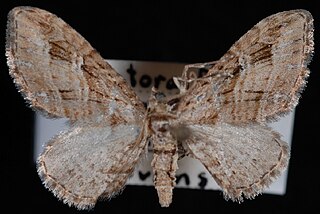
Doidae is a small family of Lepidoptera with an exclusively New World distribution, with species occurring in Central America, the south-western United States, and northern South America.

Dodia is a genus of woolly bear moths in the family Erebidae. The genus was erected by Harrison Gray Dyar Jr. in 1901. The moths are found in subarctic tundra and taiga ecosystems. They belong to the subtribe Callimorphina of tribe Arctiini.

Virbia is a genus of tiger moths in the family Erebidae. The genus was erected by Francis Walker in 1854.
Occidentalia is a monotypic moth genus of the family Crambidae described by Harrison Gray Dyar Jr. and Carl Heinrich in 1927. It contains only one species, Occidentalia comptulatalis, described by George Duryea Hulst in 1886. It is found in North America, where it has been recorded from Alberta, Indiana, Maine, Manitoba, Minnesota, New York, Ontario, Quebec and Saskatchewan.

Celiptera is a genus of moths in the family Erebidae.

Eulepidotis is a genus of moths of the family Erebidae erected by Jacob Hübner in 1823.

Hypenodes is a genus of moths of the family Erebidae erected by Henry Doubleday in 1850.

Dodia tarandus is a moth of the family Erebidae. It is endemic to Canada and found in boreal black spruce bogs and adjacent open pine uplands in central to northern Alberta, Saskatchewan, Manitoba, and Yukon.
Ceranemota albertae, the Alberta lutestring, is a species of moth of the family Drepanidae first described by John Frederick Gates Clarke in 1938. It is found in western Canada, from south-central British Columbia east to south-eastern Saskatchewan. The habitat consists of dry open woodlands and shrub areas with wild cherry.

Euxoa adumbrata, the sordid dart, is a moth of the family Noctuidae. The species was first described by Eduard Friedrich Eversmann in 1842. In North America it is found across northern Canada from Quebec to western Alaska, south to the northern parts of the United States, and in the mountains to Colorado. It is also found in Greenland, the coastal areas of Scandinavia and the Ural. It was recently recorded from Denmark, although this includes Euxoa lidia, which some authors regard to be a valid species.

Gillmeria albertae is a moth of the family Pterophoridae first described by William Barnes and Arthur Ward Lindsey in 1921. It is known from the mountains of Alberta near Banff.
Gazoryctra roseicaput is a moth of the family Hepialidae. It was described by Berthold Neumoegen and Harrison Gray Dyar Jr. in 1893. It is known from the mountains of western North America, including Washington, Oregon, British Columbia and Alberta.

Pediasia truncatellus is a species of moth in the family Crambidae described by Johan Wilhelm Zetterstedt in 1839. It is found in Fennoscandia, northern Russia, the Baltic region, the Czech Republic and Canada.
Eupithecia casloata is a moth in the family Geometridae first described by Harrison Gray Dyar Jr. in 1904. It is found in North America, including Yukon, British Columbia, Alberta, Saskatchewan, New Brunswick, Newfoundland and Labrador, Quebec, Washington, Montana, Oregon, Wyoming, Colorado, Utah, California, Maine and New Hampshire.

Eupithecia niphadophilata is a moth in the family Geometridae first described by Harrison Gray Dyar Jr. in 1904. It is found in North America from British Columbia and western Alberta south to New Mexico.
Nystaleinae is a subfamily of the moth family Notodontidae. The subfamily was described by William Trowbridge Merrifield Forbes in 1948.
Platytes vobisne is a moth in the family Crambidae. It was described by Harrison Gray Dyar Jr. in 1920. It has been recorded from the US states of Illinois, Indiana, Kansas, Massachusetts, Michigan, Minnesota, South Dakota and Wisconsin. The habitat consists of grasslands.

Heterocampinae is a subfamily of prominent moths in the family Notodontidae. There are at least 60 described species of Heterocampinae in North America.
Gynaephora rossii, in English known as Ross' tussock moth, is a species of tussock moth in the family Erebidae. It is widespread in the tundras and highlands of the Holarctic. It has large, furry caterpillars which seem to eat mostly saxifrages.












